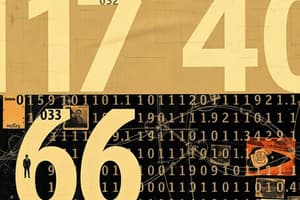Podcast
Questions and Answers
What is the binary system and why is it important for computers?
What is the binary system and why is it important for computers?
The binary system is a base-2 numeral system using only the digits 0 and 1. It is important for computers because it corresponds to the two states of electrical signals, allowing efficient data processing.
Describe the decimal system and provide an example of how to express a decimal number.
Describe the decimal system and provide an example of how to express a decimal number.
The decimal system is a base-10 numeral system that uses ten digits (0-9) and operates on powers of ten. For example, (24.5)10 = 2 × 10^1 + 4 × 10^0 + 5 × 10^-1.
What are the distinct types of computer codes mentioned?
What are the distinct types of computer codes mentioned?
The distinct types of computer codes include Machine Code, Assembly Language, High-Level Languages, Scripting Languages, and Markup Languages.
Explain what ASCII code is used for.
Explain what ASCII code is used for.
What is the significance of the hexadecimal system in computing?
What is the significance of the hexadecimal system in computing?
Flashcards are hidden until you start studying
Study Notes
Computer Codes and Conversions
- Computer codes are written in programming languages that instruct computers to perform tasks, forming the foundation of software applications.
- Types of computer codes include machine code, assembly language, high-level languages, scripting languages, and markup languages.
Number Systems
- Decimal System (Base-10): Utilizes digits 0-9; the value of each digit is based on its position relative to the decimal point. Example: (24.5)₁₀ = 2 × 10¹ + 4 × 10⁰ + 5 × 10⁻¹.
- Binary System (Base-2): Uses digits 0 and 1; fundamental to digital computing. Each digit's place value is a power of two. Example: (10101)₂ converts to (21)₁₀.
- Hexadecimal System (Base-16): Uses digits 0-9 and letters A-F (representing 10-15); provides a more human-readable format for binary data. Example: (A7B)₁₆ = (10 × 256) + (7 × 16) + (11 × 1) = 2683.
- Octal System (Base-8): Utilizes digits 0-7; often used for compact binary representation. Example: (123)₈ = (1 × 8²) + (2 × 8¹) + (3 × 8⁰) = 83.
Binary-Coded Decimal (BCD)
- 4-bit BCD: Represents each decimal digit (0-9) as a 4-bit binary number. For example, 593 in BCD is 0101 1001 0011.
- 8-bit BCD: Each decimal digit is represented by an 8-bit binary number, allowing for additional information (e.g., sign).
Character Encoding
- ASCII: American Standard Code for Information Interchange; a character encoding scheme that represents 128 characters with numerical codes.
Number Conversion Techniques
- Binary to Decimal: Add the products of binary places. Example: (10101)₂ = 21₁₀.
- Decimal to Binary: Divide the decimal number by 2, recording remainders.
- Hexadecimal to Decimal Conversion: Multiply each digit by 16 raised to the position index.
- Decimal to Octal Conversion: Convert by dividing by 8 and using remainder.
- Octal to Decimal: Use the positional values of 0-7 for each digit.
- Decimal to Hexadecimal Conversion: Divide by 16, with remainders determining the hexadecimal digits.
Example Conversions
- Convert (19.35)₁₀ to octal: (19)₁₁ = (23)₈ and fractional part approximated using multiplication.
- Convert (12.2)₈ to decimal: Evaluate using base-8 positional value resulting in (10.25)₁₀.
- Convert (2F.B)₁₆ to decimal: Using position values results in (47.6875)₁₀.
Octal and Hexadecimal Interactions
- Hexadecimal to Binary Conversion: Each hex digit converts to its 4-bit binary equivalent.
- Octal to Hexadecimal: Convert octal digits to binary, then group binary into sets of four for hex conversion.
Key Example Answers
- (32.45)₈ = (1A.94)₁₆: Steps involve converting octal to binary, then grouping into hex.
- (1A.4F)₁₆ to decimal: Evaluate using positional values to yield (26.30859375)₁₀.
Studying That Suits You
Use AI to generate personalized quizzes and flashcards to suit your learning preferences.




